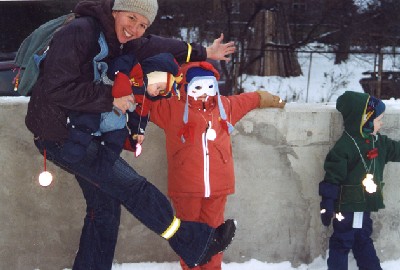
A HELKUR or pedestrian reflector is the cheapest form of life insurance in northern climes. Canadian-born Elle Palumäe has been shimmering away the dark winters in Tallinn for 10 years now. Although kids’ hats, jackets and shoes often have reflectors already sewn on, the most well known (and seen) are those hanging on a string from a coat button or zipper. Elle’s reflective team includes her kids: 6-month-old Tuuli Lea, soon to be 7-year-old Tiiu Ilo wearing her kadripäeva (St. Catherine’s Day) mask and 4-year-old Ott Jaagup.
Just as the 49th parallel separating Canada from the US and the 100th meridian, “where the great plains begin” as sung by The Tragically Hip are markers of sorts, so too is “north of 60”, undoubtedly due in part to the CBC series of the same name about life in a northern community. The prairie provinces end and Canada’s Yukon, Northwest and Nunavut territories begin at 60.
It’s interesting to imagine that Eesti, dragged due west would lie in the Nunavik region of Northern Québec between Ungava and Hudson’s Bays where “sparse black spruce, larch and fir trees give way to the more shrublike flora of the Arctic tundra.”. Or would meet Churchill Manitoba, “the polar bear capital of the world”. Thanks to Canadians’ trusty companion the Weather Network we know better than to compare weather systems brewing on the huge land mass that is North America to cycles brewing and spewing off the North Atlantic and its flirtatious gulf stream – not in the same climatic ballpark. But Kuusalu and Kuutsemäe do share sun times, the long summer days and practically non-existent winter ones, with places like Kuujjuaq.
Eesti’s Weather Network on the internet is http://www.ilm.ee, where you can see the icy Christmas lights in places like downtown Otepää and Jõgeva via webcams and get snow depths as reported by the various ski centres. The local Environment Canada is Eesti Meteoroloogia ja Hüdroloogia Instituut (http://www.emhi.ee).
On Dec. 1 the sun rose in Tallinn at 8.50 and set at 15.29. (NB > in Europe time is designated using the 24-hour clock instead of am / pm and hours and minutes are separated with a period instead of a colon.) The darkest days will bring along their antidote Christmas, with a smidge over 6 hours of day/sunlight (9.16 to 15.22) on Dec. 20 vs. Toronto’s 9+ hours. IF the sun can beat the odds, since the Baltic Sea transports an incredible cloud cover this time of year, not just Germans and Swedes in search of holiday goodies. (Go check out EMHI’s satellite picture on the web.)
It may take some getting used to, but it’s not hardcore: Icelanders will have to make due with 4 hours of light at Christmas and then there is the currently omnidark Svalbard. North of the Arctic Circle, the Norwegian archipelago’s hearty crew of 2500 live in perpetual darkness from October 26 to February 15.
Toronto lies at 43 degrees north, the parallel which brushes the south of France and the port city of San Benedetto del TRONTO on the east coast of Italy. Here too, winter means people usually get home from school and work in the dark and so pedestrian reflectors, a part of winter attire in Nordic countries for over 30 years, are now spreading to places like Australia and the UK. Small wonder then that the Moscow, Idaho pedestrian safety webpage promotes reflectors made in (where else but) Finland, where they became mandatory winter gear as of January 2003.

A pedestrian reflector manufactured by Talmu, a division of Hella Lighting Finland OY and available through C&W Distributors Canada Inc. in North Vancouver.
The helkur blitz is on in full force in Estonia as well (from the verb helkima, meaning to shimmer). They are distributed free to schoolchildren and you can be fined for not wearing one on an unlit road. Not a moment too soon either, since 13 pedestrians have been killed here this year alone, 8 of them were walking on highways after dark. By wearing a reflector, a pedestrian can be visible at 150 metres with low beam headlights, as compared to only 30 metres without one. The number of pedestrian traffic fatalities have been drastically reduced in countries where wearing reflectors is the norm. Local Estonian kindergarten kids now wear matching yellow reflector vests when out together as a group. (Like an army of little crossing guards.)
Initially most of Eesti’s helkurid also came from Finland: hard, plastic ones in various shapes, sizes and colours to hang from jacket buttons or zippers at car headlight level. Now crafty Estonians have patented ones out of soft reflective material, decorated with light-reflective paint and sparkles which have become quite the fashion accessory. And don’t break when caught in the car door! The Handelsbanken (Swedish bank’s) reflector clip on my backpack proves that they are also easily applicable for promotional purposes (in which case their quality should be controlled). Promoted as the world’s cheapest form of life insurance, pedestrian reflectors are not just for children but Elmer the Safety Elephant should definitely get on the bandwagon.

Tuuli, Tiiu and Ott – very disco and very safe. Photos: Riina Kindlam



















